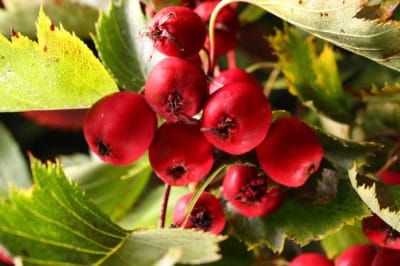Recognizing Hawthorn Trees and Berries
Both hawthorn trees and apple trees (Malus spp.) belong to the Rose family. So a family resemblance isn’t surprising; hawthorn trees look like small apple trees with very large thorns.
The trees’ clusters of white, reddish or pink spring flowers give way to clusters of red or black fall berries. About the size of crabapples or rose hips, the berries have a thin layer of pulp encasing a single large seed.
Expert gardener’s tip: Hawthorns share another apple tree trait: their seeds contain amygdalin, a compound that converts to deadly hydrogen cyanide when it reaches the intestinal tract. Never eat a hawthorn berry seed!
Hawthorn Berries as Food
Hawthorn berries were feeding the Native American tribes long before Columbus’ time. They:
- Ate them with bear meat and salmon eggs.
- Baked them on wooden slabs until they were chewy like raisins.
- Mashed them into thin cakes which they dried to use as soup crackers.
- Dried and mixed them with venison and fat to make pemmican, a high-protein, high-fat winter food.
In Denmark, the berries are distilled into schnapps and served with fish or wild game.
For your own enjoyment, think about:
- Simmering them with sugar and fresh lemon juice to make jam.
- Oven drying a simmered paste of mashed berries, apple juice, sugar and cinnamon to make fruit leather.
Hawthorn Berry Taste
The berries’ taste is most often described as mildly sour, like a crabapple. But, by timing your harvest for when they hit the peak of ripeness, you may find them surprisingly sweet.
Hawthorn Berries and Health
Hawthorn berry’s connection to heart health dates back to the first century and the Greek herbalist Dioscorides. Since then, it’s been used as a natural treatment for:
- High blood pressure
- Angina
- Hardening of the arteries
- Irregular heartbeat
- Congestive heart failure
And by the early 19th century, American doctors were also using it as a remedy for respiratory and circulatory problems.
What’s the berries’ secret? For one thing, they’re loaded with flavonoids, powerful antioxidants known to strengthen the immune system and reduce inflammation. They also improve blood flow by dilating the blood vessels and protecting them from damage.
When to Harvest Hawthorn Berries
Harvest the berries in mid-to late October, when they’re completely ripe but before the first frost. If you can wait until most of the tree’s leaves have dropped, spotting and avoiding the thorns will be easier.
